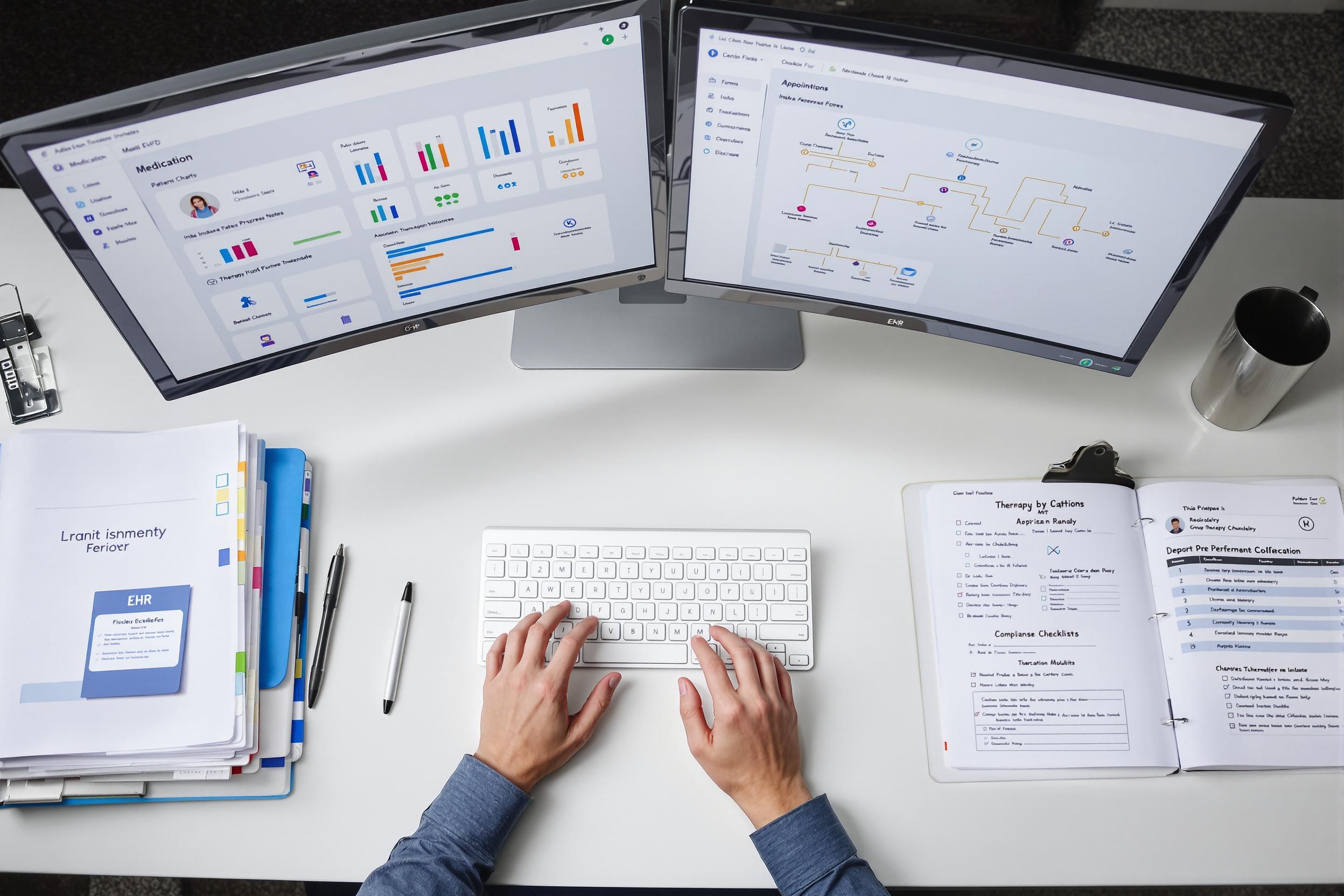
Sarah, a clinical director at Pine Valley Recovery, watched her staff struggle with three different systems for patient intake, documentation, and billing. After implementing a specialized addiction treatment EHR, her team reduced documentation time by 40% and eliminated duplicate data entry. This mirrors industry trends where U.S. drug overdose deaths declined for the first time in five years, largely attributed to improved access to evidence-based treatments. According to the AMA, telemedicine utilization in addiction treatment grew by over 50% in 2023. In 2023 the DEA eliminated the X-waiver for Suboxone prescriptions, expanding MAT access. For instance, Harborview Recovery reduced no-show rates by 30% after adopting LightningStep's integrated telehealth and appointment reminders. These shifts demand EHR systems that can adapt to changing treatment landscapes.
An addiction treatment EHR goes beyond basic medical records. It's a specialized platform designed to handle the unique complexities of substance use disorder treatment, from managing medication-assisted treatment protocols to tracking group therapy sessions and maintaining strict confidentiality requirements.
This guide covers three critical areas: key considerations for selecting the right system, must-have features that support effective treatment, and proven implementation strategies. Lightning Step addresses these needs with an all-in-one platform specifically built for behavioral health and addiction treatment centers.
Generic medical EHRs often fail addiction treatment centers because they lack specialized workflows for group therapy documentation, medication-assisted treatment tracking, and the complex consent requirements unique to substance use disorder treatment.
Compliance stands as your first priority. The updated 42 CFR Part 2 regulations require separate patient consent for SUD counseling notes and align penalties with HIPAA standards. Your EHR must handle these requirements automatically, not as an afterthought.
Clinical workflows need customization for your specific treatment modalities. You need systems that can document group therapy sessions by linking one note to multiple patient records, track individualized treatment plans, and manage longer psychotherapy notes that addiction treatment requires.
Interoperability matters more in addiction treatment than almost any other healthcare setting. Your EHR must integrate with state prescription drug monitoring programs (PDMPs), labs for drug testing, and pharmacies for medication-assisted treatment. FHIR-based PDMP integration is becoming the standard for real-time prescription monitoring. Under the 21st Century Cures Act, EHRs must support API-based data exchange to prevent information blocking.
Lightning Step's platform includes built-in 42 CFR Part 2 compliance, flexible template builders for custom workflows, and HL7/FHIR integration capabilities that connect seamlessly with external systems.
Your EHR should include validated screening instruments like AUDIT, CAGE, or DAST-10 with automatic scoring and risk flagging. These tools show sensitivity rates of 80%-90% when properly integrated into EHR workflows. Self-administered EHR-integrated screenings have been feasible in rural FQHC clinics, detecting substantial alcohol, cannabis, and tobacco use.
Care plan templates must support individualized treatment goals and track progress over time.
Lightning Step offers a drag-and-drop intake builder that lets you create custom assessment forms with real-time scoring and automatic care plan generation based on patient responses.
Your EHR should include secure video conferencing, SMS appointment reminders, and mobile portal access. Features for virtual group sessions and remote check-ins help reduce no-show rates and maintain patient engagement between visits.
RPM is increasingly covered by insurance for addiction treatment programs, making it a valuable revenue opportunity. Studies show telehealth offers real-time patient–provider interaction, while RPM excels at continuous symptom monitoring.
Data analytics drive treatment improvements. Your EHR should provide custom dashboards for census tracking, retention rates, return on investment, and accreditation reporting requirements.
Outcome measurement tools support data-driven care decisions. The system should track patient progress using standardized metrics and provide predictive analytics to identify patients at risk of relapse or dropout.
Lightning Step includes prebuilt KPI dashboards and an ad-hoc report writer that lets you create custom reports for specific accreditation requirements or internal quality improvement initiatives.
Form a steering committee that includes clinicians, IT staff, compliance officers, and administrative personnel. Each group brings different perspectives on workflow requirements and success metrics.
Conduct workflow mapping sessions to identify current pain points and define what success looks like post-implementation. Document existing processes before changing them so you can measure improvement accurately.
Lightning Step's discovery workshops help align stakeholders on requirements and create realistic timelines for implementation based on your center's specific needs. Include training modules on leveraging LightningStep's AI assistant LIA to automate documentation templates and streamline clinician workflows.
Audit your existing patient data before migration. Clean, standardized data ensures a seamless launch and maximizes ROI from day one. Ensure all transfers use encryption in line with ONC guidelines and the 21st Century Cures Act to safeguard PHI during migration. Refer to ONC's EHR Data Migration Playbook for a step-by-step checklist on FHIR compliance and Cures Act standards.
Configure user roles and permissions carefully. Addiction treatment centers often have complex staffing models with different access needs for counselors, medical staff, and administrative personnel.
Lightning Step provides dedicated data import tools that handle the technical aspects while you focus on training and change management.
Develop role-based training plans rather than one-size-fits-all approaches. Clinical staff need different training than billing personnel. Consider super-user certification programs to create internal champions.
Schedule go-live support, regular check-ins, and refresher courses. Plan for ongoing optimization, updates, and staff refreshers as part of your adoption strategy.
Implement feedback loops with your vendor's customer success team. The best EHR implementations involve continuous optimization based on real-world usage patterns and changing regulatory requirements.
Selecting the right addiction treatment EHR requires careful evaluation of compliance capabilities, specialized features, and implementation support. The three pillars - key considerations, must-have features, and implementation strategies - provide a framework for making this critical decision.
Lightning Step's AI assistant LIA saves clinicians over 12.5 hours monthly on documentation tasks, while our single-login system eliminates duplicate work across CRM, EMR, and RCM functions. Download our free Addiction Treatment EHR Selection Checklist and request a Lightning Step demo to see how our specialized platform addresses the unique needs of addiction treatment centers.



